#Oberst and Major
Explore tagged Tumblr posts
Text

Page from Ottoway vol 2. Little Hetalia!Germany cameo in the far left of the bottom panel. My Wwi OCs, in order of who speaks, are Wilhelm Adelmann, Vincent Odinkirk and Siegfried Isenstein.
#ottoway#ww1 fiction#my art#wwi#german#ww1#original comic#volume 2#cameo#original art#original character#wilhelm adelmann#vincent odinkirk#oberst odinkirk#Siegfried Isenstein#major isenstein#hws germany#hetalia
8 notes
·
View notes
Text

Future Oberst and Ritterkreuz mit Eichenlaub, Schwertern und Brillanten (Knight's Cross with Oak Leaves, Swords and Diamonds) holder, Major Hermann Graf. Seen here as a Major, he would claim 212 victories from about 830 missions and was Geschwaderkommodore of JG 50 and JG 11 before ending the war as Geschwaderkommodore of JG 52. Surrendering his unit to the Americans on 8 May 1945, they were handed over to the Russians. Graf spent four years in Siberia before being released in 1949. He was the first pilot in history to claim 200 victories and died in 1988. For more, see my Facebook group - Eagles Of The Reich
28 notes
·
View notes
Text
The Germans of Stalag Luft III
One of the films which got me interested in WW2 from an early age is The Great Escape (1963) which is based on the 1944 escape from Stalag Luft 3.

The escape was famous for the sheer number of men who escaped at one time but also the unlawful execution of 50 of the escaped prisoners by the Gestapo on Hitler’s orders.
Apart from the inventiveness of the escape itself, one thing what drew me to the film was the way in which the German officers and guards of the POW camp were depicted. Instead of being cruel and cold these Germans were shown as understanding and considerate. Given that the film was supervised by former POWs and having read several books and articles on the subject there is evidence to show much of this was true for the Luftwaffe camp staff of Stalag Luft 3 and conditions were reportedly a lot better than in other POW camps.
The books talk about life in the camp and also describe the staff of the camp in detail. The person that stands out the most is the Commandant who was based at the camp from 1942 up until the escape in 1944 which led to his court martial. He was remembered by the prisoners for adhering to the Geneva Convention but was also someone they had respect for although they did occasionally pull pranks on him and his staff.
I think it’s important to remember him as a man who did his best given the position he was in but also for being a genuinely good person.
Oberst Friedrich Wilhelm von Lindeiner-Wildau 1880 - 1963

Lindeiner had opposed the Nazi party from as early as the first elections. One reason for this was he had lived with his Dutch wife in the Netherlands in the early 1930’s and could see the effects the Nazis were having on Germany from an outsider’s perspective.
He had been a Colonel in the First World War and had tried to retire before accepting his position as the Commandant of Stalag Luft 3 but was refused due to his high rank. Although not the best outcome he was relieved to be away from the front lines. He was already 62 years old when he took command of Stalag Luft 3.
From his arrival at the camp he sought to improve living conditions for the POWs. Although food rations were beyond his control he discovered Red Cross Parcels were going missing and put a stop to this. He liaised with the senior officers to ensure the men had access to adequate leisure facilities and worked with the YMCA to see this was done. He discussed ways to improve sanitation and a saw that a sewer system was built for the camp, something the nearby German town of Sagan didn’t have.
Orders from High Command were often confusing and contradictory however Lindeiner instructed his staff to treat prisoners as they would wish to be treated. Orders denied prisoners who had died in the camp the right to be buried with military honours but Lindeiner still insisted on this. The orders also depicted on how prisoners should be treated according to country depending on each country’s status. For example Russians could be used for manual labour and were denied by the German government the conditions of the other prisoners had a right to. Lindeiner improved their conditions the best he could despite warnings of close friends that the High Command was keeping tabs on him. He was certain there were men on his staff who were reporting his behaviour.
When he learned through British POWs that the Gestapo was holding a number of prisoners in their custody he began action which would see the prisoners transferred to the Luftwaffe’s care and to his camp. He also intervened when Dutch prisoner Bram Van Der Stok was almost tricked into leaving the camp with the Gestapo, fortunately both Van Der Stok and Lindeiner guessed what they were up to.
When orders from the OKW in early 1944 stated the escaped prisoners should be handed to the Gestapo, Lindeiner feared he may be given an order to execute prisoners within his camp. He later told his deputy Major Gustav Simoleit his concerns about receiving such orders and they both concurred they would rather be executed themselves for insubordination than carry out such an order.
The actual order for the gestapo to execute the escaped prisoners was protested by Göring and a number of senior Wehrmacht officers.
At his court martial in 1944 he was charged with transferring staff whose views were too National Socialist. He denied these claims but said he did remove any staff whose conduct was not morally correct or who didn’t adhere to the Geneva Convention which he made a point of following. He was also charged with being too friendly with the POWs, it was noted he had spent much time speaking with the prisoners and given some of them gifts on their birthdays. He had had a very good relationship with the Senior British Officer.
He was tried by the allies after the war and a number of former POWs testified to his character during his time as the Commandant. Letters were exchanged between himself and former prisoners after the war up until his death.
Stalag Luft III Staff
Lindeiner’s deputy Major Gustav Simoleit, and Captain Hans Pieber were of similar minds and also well respected by the POWs. Simoleit attended the prisoner re-union in 1965 and Pieber was reported to have been visibly upset when he learnt of the executions. It was also said that Pieber turned a blind eye to a few of the escape related activities including lending his camera to the POWs without asking questions.
Another man who was extremely popular with the POWs was Oberfeldwebel Hermann Glemnitz, the sergeant of the Trackers (Ferrets). Unlike his counterpart in the film he was a likeable character showing more curiosity about methods than anger over foiled escape attempts. He attended several of the reunions and even visited a former POW in Canada.

The camp employed hundreds of staff and many of these were too old for military duty, recovering soldiers with injuries and sole survivors in families. Food rations for the staff were similar to that of the prisoners minus the Red Cross parcels so actually worse overall. It was due to this so many of the guards were able to bribed into assisting with the 1944 escape, around 100 in all, but several actually went out of their way to assist including a guard in the watchtower who distracted his colleague while an escape took place but the plan failed and another guard whose wife made stencils for official documents and mailed them back to the camp from her home in Hamburg. It was unfortunate that the relationship between some of the guards deteriorated after the heavy bombing of German cities later in the war.
Recommend books about Stalag Luft 3
The Great Escape: The Full Dramatic Story with Contributions from Survivors and Their Families - Anton Gill
Escape from Stalag Luft III: The True Story of My Successful Great Escape: The Memoir of Bob Vanderstok - Bram Van Der Stok
The True Story of the Great Escape: Stalag Luft III, March 1944 - Jonathan Vance
From Commandant to Captive: The Memoirs of Stalag Luft III Commandant Col. Friedrich Wilhelm von Lindeiner genannt von Wildau - Marilyn Jeffers Walton

7 notes
·
View notes
Text

Iron Cross No. 1 (2019) . Quarterly magazine focussing on German Military History from 1914-1945. The cover, by Keith Burns, depicts the Focke-Wulf Fw 190 of Oberst. Josef Priller strafing Sword Beach.
An article inside explains that it is a myth, perpetuated by the book The Longest Day, that only two Luftwaffe fighters (Priller and his wingman) made an appearance on D-Day but does add the majority of other Luftwaffe engagements were against Allied planes as opposed to strafing the beaches.
13 notes
·
View notes
Text

“Jeff Way In His Tribeca Loft”, 2023; “Turtle Owl Death Mask”,2018 and “Egyptian Violet Gorilla Mask”, 2017

Kimiko Fujimura “Party-3 (Party at Peter’s)", 1990, and “Kimiko Fujimura in her Chinatown Loft”, 2023
For his current exhibition, Loft Law, on view at Westwood Gallery, documentary photographer and filmmaker Joshua Charow photographed artists living and working in the remaining spaces still protected by Loft Law in NYC. The well-crafted portraits offer a chance to see how the artists have made these spaces home over the years.
The gallery has also included artwork by eleven of the artists featured in the photos- Carmen Cicero, Loretta Dunkelman, Betsy Kaufman, Kimiko Fujimura, Joseph Marioni, Carolyn Oberst, Marsha Pels, Gilda Pervin, Steve Silver, Mike Sullivan, and Jeff Way.
From the gallery-
In 1982, Article 7-C of the Multiple Dwelling Law, also known as the Loft Law, was passed in New York City. The law gave protection and rent stabilization to people living illegally in manufacturing and commercially zoned lofts. Hidden behind this legislation were thousands of artists who needed a live/work environment at an affordable rent. These artists protected by the Loft Law changed the trajectory of New York’s cultural landscape.
Three years ago, Charow found a map of the remaining buildings with Loft Law protection. He rang hundreds of doorbells to find and photograph over 75 Loft Law tenants across the city to document the last of these incredible spaces and the creative individuals who made them home. Charow’s interest in the Loft Law and the vanishing history of New York stemmed from his early teenage years when he became immersed in a subculture called ‘Urban Exploring,’ the practice of illegally climbing skyscrapers, bridges, and abandoned subway stations. One of the rooftops he visited was an old factory building in South Williamsburg, where a tenant explained to Charow about the building’s remaining tenants under Loft Law protection.
The photos are a living visual document of the expansive spaces: old flophouses on the Bowery, garment factories in Tribeca and SoHo, glass factories in Greenpoint, and even a former ice cream factory in DUMBO. From the 19th to the 20th century, many buildings in NYC, including SoHo, were manufacturing centers for items from sewing machines to textiles to printing houses. The massive light-filled loft spaces with high ceilings were left empty when these businesses vacated in the mid-1900s and moved to other areas outside of New York City. The industrial-zoned lofts were not legal to live in, as they did not meet the building requirements for residential use, and oftentimes were completely raw spaces without a kitchen, shower, plumbing, or even heat. However, artists were attracted to these large spaces where they could work and create at any hour of the day. At the end of the 1970s, loft living started gaining attention in the media and the wealthy started to become attracted to this lifestyle. Soon landlords began to evict the artist tenants in favor of a wealthier clientele. A group of artists formed the Lower Manhattan Loft Tenants and spent years lobbying in Albany to gain legal protections and rent stabilization. At the time the Loft Law was first passed, there were tens of thousands of artists living in lofts across the city. Today, only a few hundred artists protected under the original 1982 Loft Law remain. This exhibition marks one of the first documentary insights into this vanishing history.
The majority of Charow’s images depict painters, sculptors, photographers, musicians, and filmmakers captured amidst their industrial loft spaces. Notable portraits include experimental music and film artists Phillip (Phill) Niblock (1933-2024) and Katherine Liberovskaya (b. 1961); Phill was instrumental in the avant-garde music and film scene from the 1960s to the present. Visuals artists include 97-year-old abstract and figurative expressionist Carmen Cicero (b. 1926), who has works in the collections of the Guggenheim Museum, Museum of Modern Art, and Whitney Museum; Kimiko Fujimura (b. 1932), who in 1965 was selected as “Japan’s Top 5 Female Painters in Contemporary Art” by Geijutsu-Shincho, a Japanese monthly art magazine; minimalist painter Loretta Dunkelman (b. 1937), a co-founder of the all-female artists cooperative A.I.R. Gallery; and Gilda Pervin (b. 1933), whose studio occupies the top floor of a 1790s Quaker building linked to the Underground Railroad and happens to be the old studio space of famed sculptor Eva Hesse, who worked there from 1965-70. Also included is Chuck DeLaney, co-founder of the Lower Manhattan Loft Tenants, an early activist group that was responsible for the lobbying and passing of the Loft Law.
This exhibition closes on 7/13/24.
#Joshua Charow#Westwood Gallery#Art#NYC Art Shows#Photography#Art Shows#Kimiko Fujimura#Jeff Way#Artist Documentaries#Betsy Kaufman#Carmen Cicero#Carolyn Oberst#Documentary Photography#Gilda Pervin#Joseph Marioni#Loft Law#Lofts#Loretta Dunkelman#Marsha Pels#Mike Sullivan#Mixed Media Art#New York Art Shows#NYC Artists#NYC Tenant Law#Old New York#Painting#Sculpture#Steve Silver#Artist Housing
0 notes
Text

Burian, Ewald
Date of birth: July 12th, 1896 (Tschernowitz, Romania)
Date of death: November 3rd, 1981 (Köln-Lindenthal, Germany)
Nationality: German (1933-1945, Third Reich)
The following press article describes why Burian was awarded the Knight’s Cross…
“The Commander is the Soul of the Resistance - Oberst Burian and his Grenadiers hold off the Anglo-American onslaught:
During the hard fighting south of Caen Oberst Ewald Burian, the commander of a Grenadier-Regiment, has repeatedly proven himself as an especially flexible and crisis-proof commander. Strong English tank forces penetrated through the frontline on multiple occasions, threatening to encircle major German formations. With tireless calm the brave regimental commander gathered up all the scattered friendly troops and sent them into battle anew.
As a truly tireless leader of his Grenadiers, he distinguished himself even as the enemy thrust into the retreating German units from the south following a wide flanking maneuver. Immediately recognizing the extremely critical situation for the entire front, Oberst Burian rallied all available forces together and used them to create a bridgehead. From here he frustrated all the English intentions at a breakthrough. Using a swiftly brought-up Füsilier-Bataillon he also smashed an enemy flanking thrust further to the north.
During these battles Oberst Burian constantly fought in the foremost line as the soul of resistance for his brave Grenadiers. With unfailing spirit he conducted the defense and withdrawal movements of his Regiment, and with ruthless energy he secured the orderly withdrawal of all heavy weapons behind a new frontline for the entire Korps. This brave officer also showed himself to be a prudent and flexible commander in all crisis situations in the subsequent combat, and in recognition of his efforts the Führer awarded him the Knight’s Cross to the Iron Cross.”
The battle referred to in the article was from the combat during Operation Tractable. On the 14.08.1944 the Allies broke through along both sides of the Caen-Falaise road, breaching the gap between the I. SS-Panzer-Korps and the 272. Infanterie-Division at Maizieres and Ernes. By doing so they got into the deep southern flank of the Division. In the combat which followed Oberst Burian and his men held the regimental command post at Conde sur Ifs against much larger Allied forces, and on the evening of that day he recaptured the temporarily lost village of Ifs sur Laison.
0 notes
Text
Day 21 - Okay, Blue Jays!
Gestern kam ich bei meinem ersten Spaziergang durch Toronto am Rogers Centre vorbei (wie viele Stadien sponsort Rogers Communication eigentlich?), als vor den gates der Arena und überhaupt in der ganzen Innenstadt tausende Leute mit blauen Trikots auftauchten. Das Stadion ist Heimspielstätte der Toronto Blue Jays, die in der Major League Baseball vertreten sind. Nach kurzer Recherche hatte ich den nächsten Spieltermin herausgefunden (an mehreren Tagen hintereinander spielen die Blue Jays gegen die Kansas City Royals, warum muss ich noch nachlesen) und ein Spiel beginnt heute um 13.37 Uhr (wozu diese seltsame Uhrzeit muss ich auch noch recherchieren). Tickets gibt es nur online zu kaufen und diese muss man über den Bildschirm des Handys beim Einlass scannen lassen. Ich habe mir einen Platz für 30$ auf den billigsten Rängen gesichert, kaufe mir an einer Straßenecke natürlich den obligatorischen Hot Dog und erscheine auch erst ca. 15 Minuten nach Startschuss (vielleicht nicht das richtige Wort beim Baseball) am Eingang - so ein Spiel kann ja ohne Probleme vier Stunden dauern, da macht ein wenig Verspätung wohl kaum etwas aus. Zunächst laufe ich einen langen Tunnel nach oben...

... und erreiche dann die oberste Ebene, wo sich ein Tunnel mit Fressbuden, Computerspielen, dem sog. park social und weiteren Animationen auftut. Nach ein paar Augenblicken der Orientierung gehe ich zu meiner Tribüne und meinem Sitzplatz - die Treppe ist steil, ich sitze in schwindelerregender Höhe in der vorletzten Reihe des Stadions, das bei Baseballspielen über 40.000 Besucher:innen fassen kann. Das Dach ist heute geöffnet und erst nach 10 Minuten bemerke ich, dass man freien Blick auf den CN Tower hat. Zuvor war ich damit beschäftigt, nicht in die Tiefen der Arena hinabzustürzen und die Regeln des Spiels zu begreifen.



Die Zeit vergeht im Flug, zudem gibt es über den gigantischen Bildschirm Einspieler und live Videos, zwischendurch fliegen auch tatsächlich Bälle als Homeruns und durch Fehlschläge in die Ränge der Zuschauer:innen. Neben mir sitzt eine Frau allein mit ihren zwei etwa achtjährigen Kindern - würde eine Mutter in Deutschland allein mit ihren kleinen Kindern ins Fußballstadion gehen? Es wirkt auf jeden Fall alles sehr entspannt und family friendly!
Die Blue Jays setzen am Ende noch ihren Spitzenwerfer als Geheimwaffe ein, was das Publikum lauthals anfeuert (Okay, Blue Jays!), sie gewinnen schließlich mit 5:2 (runs?), nach 9 Innings und vier Stunden ist das Match vorbei.

0 notes
Text
J.A. HOBSON. SKY CALENDAR, BAR HOME. SPECULATES.
Conor Oberst is a very privileged man. His parents were part of the amazingly vibrant financial services and insurance racket in Omaha, Nebraska. For several years my dream has been to move there, or Chicago, IL. Anyhow it's Commenting on socialism like me with an educator and a materials scientist as parents. Yeah I had it hard. Sure. Still, actually when you're intelligent or privileged you're still always outside of normality. Normality by definition. I don't feel it's as an existential sense out outside-ness that others experienced. I was not a minority, a woman, or poor. My parents earned over the median income, and had a happy fairytale marriage, and devoted everything to us. I imagine Conor Oberst enjoyed the same and more. He was a white, CIS-male from a banking family, and he never fell into the poverty of drug addiction and street scams like myself, but that's only because he could write songs. Inwardly, I'd hate to admit but otherwise his trajectory is the same. Now where did he pull J.A. Hobson from? I'd never heard the name until the deep dive The kind of deep dive into a subject only a maniac knows The kind that leaves bruised fists as you punch a cinder block Time and again pursing your lips over the blood I knew that he (Hobson) was a major influence on Lenin I knew that he advocated the theory of underconsumption To avoid all the words that's not supposed to happen Demands is always supposed to be insatiable Any recession is the fault of producers Not so said Hobson. The demand contracts It's happening right now and he's dead His corpse was invoked to analyze the market In a fucking early 2000s album So a girl who was 16 years old at the time showed me this She liked the music It's no less valid than liking a lyric All of us could cringe at a line or two our favorites belted But then I saw the connect There was thumbtacks and strings
The one I gave you in 2031.
What was I saying? "John A. Hobson was a good man He used to loan me books and mic stands He even got me a subscription To the Socialist Review Listening to records in his basement Old folk songs about the government "It's love of money, not the market" He said, "these fuckers push on you"
"And freedom yells, it don't cry Whatever sells will decide But there's no hell when you die So don't look so worried"
He got a night life, lost his day job Pushing papers, swinging pendulums Anything to serve a function Or to occupy some time
You gotta earn this living somehow You're good as dead without a bank account But it's funny how alive he felt down In that unemployment line
With all that trash at his feet The pools of piss in the street All of that filthy empathy For the way we're feeling
The billboards shade The flags they wave The anthem was playing loud The baseball game was letting out
And all at once He saw the dust And heard every tiny sound Got in his truck and turned around
Drove out through the crowd and the cops Drove out past that center mall Drove out past that sickening sprawl Out past that fenced in gold
And maybe he lost control Fucking with the radio But I bet the stars seemed so close At the end At the end."
youtube
1 note
·
View note
Text
It wasn't the first time her fate was decided as if she were a third party in the room. No true say nor defense to be offered. She had played a double agent majority of her life, the only way out was a bullet between her eyes.
One day it'd come, Laura knew that.
"We should have passed a side road on the way here. It's probably so overgrown that vehicles won't be able to traverse it. But it-" Laura hesitated. Who's to say any of these men would trust her now? So she had told the truth, but very clearly it was a bit too late. Her previous aid to the allies evaporating like that into thin air. "It'll lead to the back of the factory. No one will see you. Not even the sniper."
She had to offer an act of trust. The only thing she had was her life, not even sure if it meant much to anyone. "If it comes down to it, you can use me as collateral. I'm sure that Oberst Muller would rather have his daughter alive."
Alive, so that he could deal with her failure himself.
@maximalcatpossible
“What do you mean your role”, Cowboy asked, and paused as he put the pieces together, “You set us up, didn’t you?!”
With the cat out of the bag, the group of men now knew they had a snake in their ranks. While she was worried about Gator grabbing her, it was Whiskey who took Laura by the shoulders and shoved her against a wall.
“You we’re going to send us to die”, Whiskey said what they were all thinking. “We should’ve known not to trust you damn Germans!”
“What do we do with her now”, Cowboy asked, unsure of how to proceed with the rest of this.
“I say we put a bullet between her eyes right here”, Angel said, “One less nazi to worry about.”
Now Laura was at the complete mercy of the group. They all absolutely hated Nazis and in their eyes, Laura was one of them. However, one of them said otherwise.
“WAIT”, Roy shouted, getting all eyes to face him. “We need her. She may be a Nazi, but she can still be useful.”
“Shamrock”, Bronx asked Roy, “You’re not REALLY saying we should trust her and rush this base?!”
“There’s enemies everywhere and the best goddamn sniper in all of Germans is waiting up there”, Angel added.
“Would any of that have stopped Maxx from finishing what we started”, Roy asked them all.
Almost like magic, his words brought a new enlightenment to them all. There was a deep pause as everyone considered what he said.
“Laura, is it still possible to get in there undetected”, Roy asked Laura.
95 notes
·
View notes
Text
Evie's Multiverse Trading Cards: Hogan’s Heroes Pack 1 - Germans
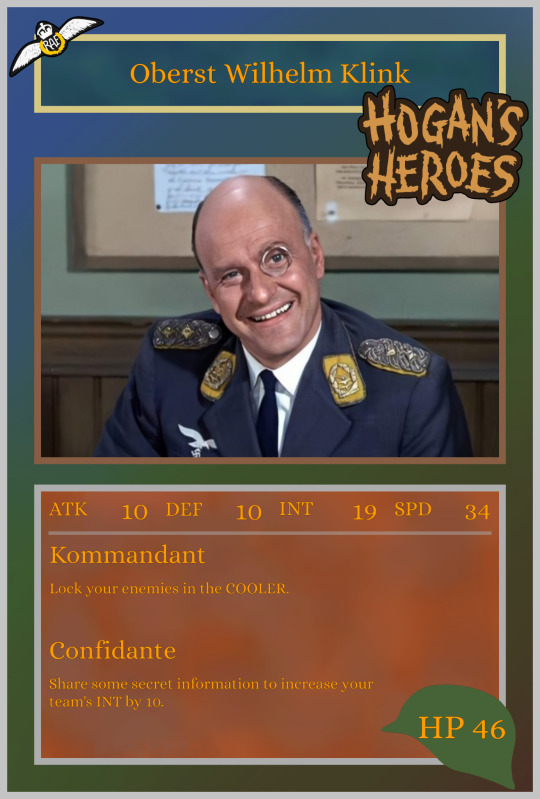
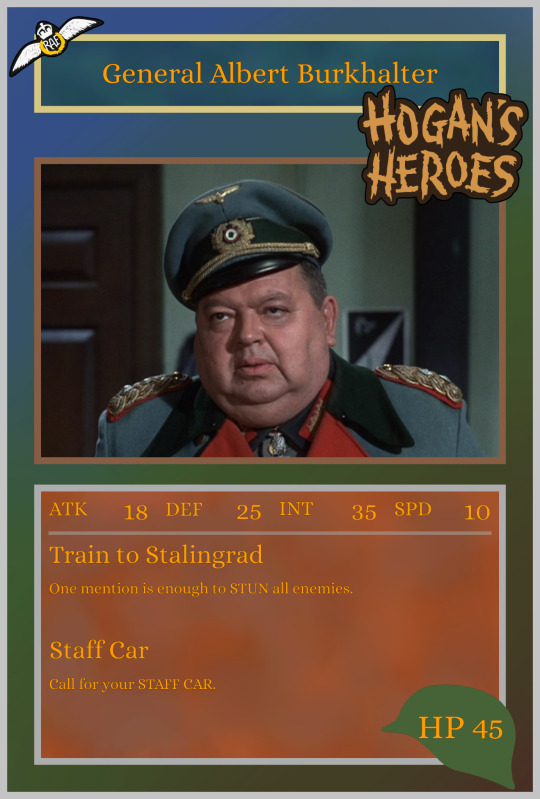
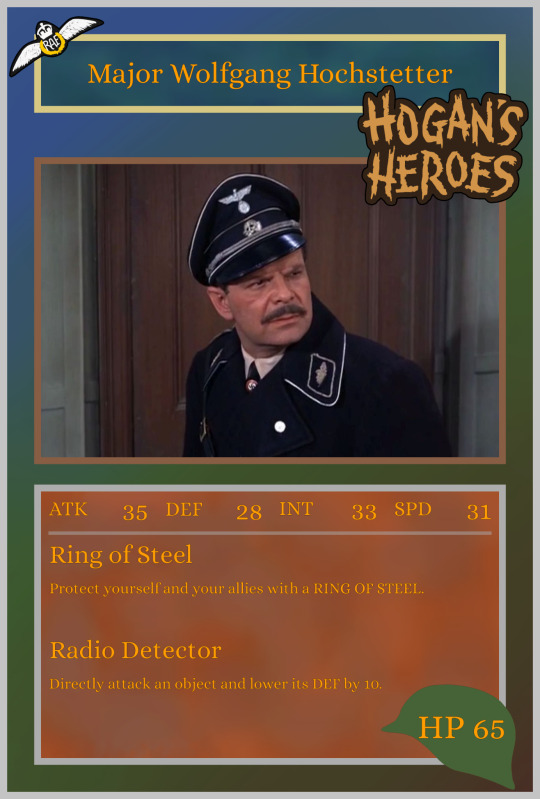
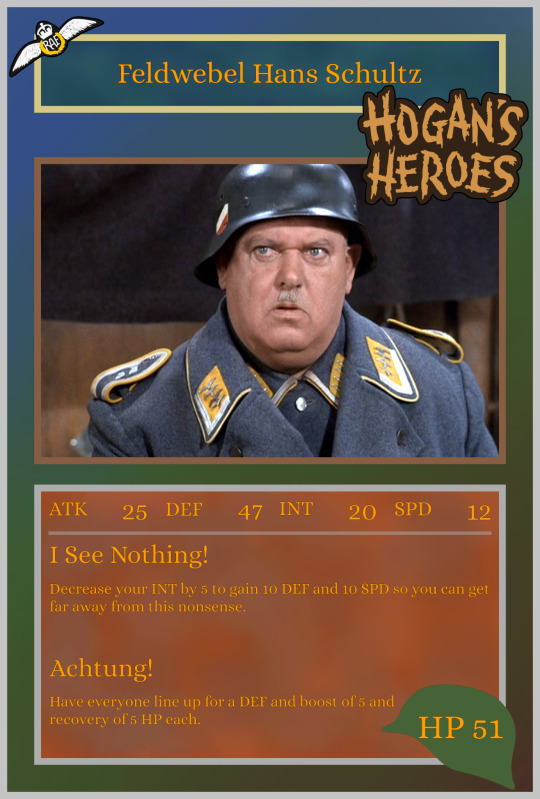



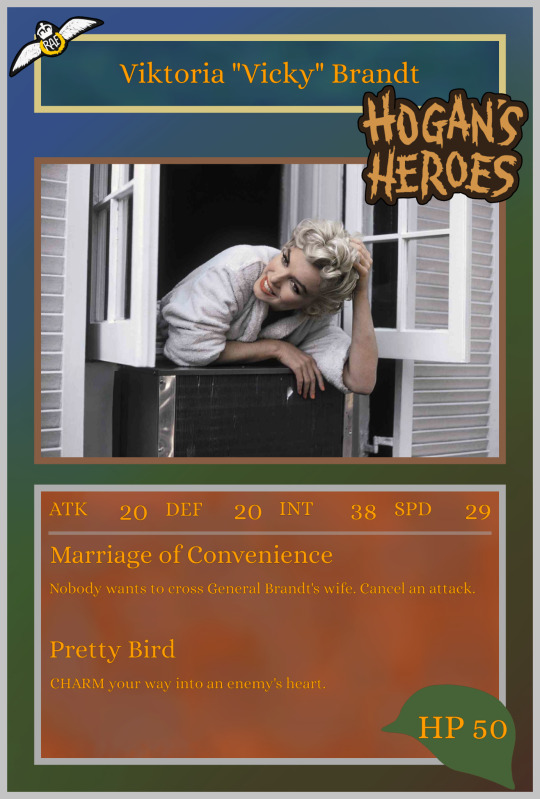
What do you mean "Vicky doesn't belong here"? She's 100% on the Germans' side, totally not a spy or anything, definitely not dating Newkirk, nooooo... I see nothing. Nothing!
Also, I decided to give them their more accurate German ranks - except for Hochstetter because he's addressed as "Major" even in the German dub, so... Let's say it's a nickname. In case you're interested, his real ranks would be "Sturmbannführer" and "Kriminalrat" for SS and Gestapo respectively.
#hogan's heroes#oberst klink#general burkhalter#major hochstetter#feldwebel schultz#karl langenscheidt#fräulein hilda#fräulein helga#oc: vicky brandt#evie's multiverse trading cards#character cards
11 notes
·
View notes
Text
Oberst Klink, zu Major Hochstetter und Colonel Hogan:
"Acht hat er gefasst,
der Gast erblasst,
und der Bombast wird nur gehasst,
denn der Ballast hängt am Ast,
und der Egon kommt in Knast.
Da sind se platt, he?"
#Hogan's Heroes#Oberst Klink#Colonel Klink#Colonel Hogan#Hogan#Klink#Hochstetter#Major Hochstetter#Wolfgang Hochstetter#Ein Käfig voller Helden
5 notes
·
View notes
Text

Line art for Major Isenstein and Oberst Odinkirk. Characters from my original ww1 fictional graphic novel Ottoway.
#imperial germany#wwi fiction#officers#iron cross#spurs#major#oberst#siegfried isenstein#vincent odinkrik#jackboots#line art#character concept#this belt grab was not meant to look so seductive T.T#i need to borrow you#comrade
9 notes
·
View notes
Text

Luftwaffe Ritterkreuz mit Eichenlaub (Knight's Cross with Oak Leaves) award ceremony at the Berghof, 4 April 1944. L-R: 68 victory ace (67 at night) Oberst Werner Streib, 301 victory ace Major Gerhard Gerd Barkhorn, Generalmajor Erich Walther (he and his Fallschirmjäger regiment defended Monte Cassino), 112 victory ace (including 14 four engined bombers) Oberstleutnant Kurt Bühligen, 50 victory ace (31 at night) Oberstleutnant Hans-Joachim Jabs, Oberstleutnant Bernhard Jope (a medium and heavy bomber pilot who took part in sinking the Italian battleship Roma using Fritz X radio controlled guided bombs on 9 September 1943), 109 victory ace (9 with the Legion Condor) Major Reinhard Seiler, Adolf Hitler, 352 victory ace Major Erich Hartmann (blocked by Hitler), 166 victory ace Major Horst Ademeit (MIA 7 August 1944), 133 victory ace Major Johannes Wiese (including 50 IL-2 ground attack aircraft), Wachtmeister Fritz Petersen (air defense commander/flak), Major Doktor Maximilian Otte (a Junkers Ju 87 Stuka pilot with 1,179 combat missions who was KIA 20 May 1944 by Soviet flak during the First Jassy-Kishinev Offensive), 197 victory ace Hauptmann Walter Krupinski. Krupinski was one of the first to fly the Messerschmitt Me 262 jet fighter into combat, claiming 2 kills in April 1945 as a member of JV 44 led by 104 victory ace Generalleutnant Adolf Galland
#germany#ww2#luftwaffe#adolf hitler#werner streib#gerd barkhorn#erich walther#kurt bühligen#hans joachim jabs#bernhard jope#reinhard seiler#erich hartmann#horst adameit#johannes weise#walter krupinski#fritz petersen#maximilian otte#adolf galland#knights cross#jv 44#the berghof#1944
46 notes
·
View notes
Photo








Penny Johnson Jerald as Dr. Claire Finn 2017 in The Orville “Majority Rule“
https://www.imdb.com/title/tt6845666/
#Star Trek#Star Trek TNG#Penny Johnson Jerald#Die oberste Direktive#Homeward#Kasidy Yates#Star Trek DS9#Captain Victoria Gates#Castle#Dr Claire Finn#The Orville#Majority Rule#Mehrheitsprinzip#Isaac#Mark Jackson#Peter Macon#Lt. Cmdr. Bortus#Halston Sage#Alara Kitan#Seth MacFarlane#Ed Mercer#Captain Ed Mercer#Lt. Gordon Malloy#Scott Grimes#Giorgia Whigham#Lysella
6 notes
·
View notes
Text
"you've spent your whole life sweating in an endless fever
now you're laying in a bathtub full of freezing water
wishing you were a ghost"
a perfect sonnet // bright eyes × every day and every night EP
#bright eyes#conor oberst#a perfect sonnet#every day and every night#music#lyrics#song#songs#song lyrics#sad lyrics#bpd#borderline#borderline personality disorder#depression#major depression#mdd#major depressive disorder
6 notes
·
View notes
Text

Büroakut beschäftigt sich seit 1986 mit recycling und tagesrückständ verliert immer von neuem seine ateliers und sein zuhause und weil er dauernd rennen muss, ist er bereits alt geworden. aber noch jung genug um zu hoffen etwas neues zu finden, ein Stall leerstehendes Gebäude Zwischennutzung ist auch eine möglichkeit oder mietkauf. egal die wünsche sind lebendig.
#teerec#teebütelirecycled#acrilrecycled#recyclingart#recycledart#antifrost#frogomatiker#artantifrost#art#antifrosttext#oberst#major#schlichtungsrichter#kunstgarten#antifrostrecyclingart#wegradieren#zerstöhren#sexartrecyclen#büroakuten#artlokal#villa#leerstand#haus#zwischennutzung#tagesrückständ#atelier#zuhause#gebäude#fabrik#saustall
0 notes